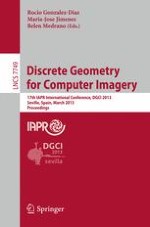2013 | Buch
Discrete Geometry for Computer Imagery
17th IAPR International Conference, DGCI 2013, Seville, Spain, March 20-22, 2013. Proceedings
herausgegeben von: Rocio Gonzalez-Diaz, Maria-Jose Jimenez, Belen Medrano
Verlag: Springer Berlin Heidelberg
Buchreihe : Lecture Notes in Computer Science
